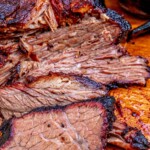Brisket Hot and Fast
Delicious juicy, smoky brisket in about half of the time it takes to traditionally smoke a brisket.
Servings: 12 servings
Equipment
Ingredients
- 14 lb brisket
- Brisket Rub:
- 2 tbsp garlic powder
- 2 tbsp onion powder
- 2 tbsp paprika
- 2 tbsp chili powder
- 2 tbsp kosher salt
- 2 tbsp coarse ground black pepper
- 1 tbsp brown sugar
Instructions
- Prepare your smoker. Light your fire and allow the charcoal to burn for 15-20 minutes until the grey/black smoke is replaced with thin, wispy blue smoke. Bring the temperature to 300 degrees Fahrenheit.
- Trim brisket, removing any excess fat.
- Season your brisket aggressively with your rub of choice. Remember, it’s a large, thick piece of meat, so use more seasoning on the outside than you think you should. You can season up to 36 hours in advance, which helps build and establish a good bark on your brisket.
- Place on smoker grill, fat side down, and smoke your brisket until it hits an internal temperature of 160-170. I highly recommend using a disposable foil pan with water in to catch fat drippings and prevent flare-ups in your smoker. The water also helps keep the brisket moist. This should take roughly 2-3 hours depending on the thickness of your particular piece of meat, your cooker, and ambient temperatures.
- Depending on your cooker you will want to keep your smoker between 295-325F for this hot and fast brisket cooking session. With pellet smokers, it's easy to hold the temperature right at 300F, but with charcoal or wood burners it takes more skill to hold it at a precise temperature.
- Wrap brisket in kraft paper or aluminum foil when it has reached 160-170 degrees Fahrenheit.
- Cook your wrapped brisket until in reaches 205-210 degrees internal temperature. This should take approximately 2-2.5 hours, but check the temperature to be sure. The rule of thumb is that your meat is done when the sharp probe slides through the meat like hot butter.
- Once your brisket hits the temperature, remove it from the smoker, keep it in foil or butcher paper wrap. Wrap it in a towel and then put it in a clean, dry cooler to rest for at least an hour. This rest keeps the meat juicy and helps to keep it tender.
- After resting at least one hour, slice against the grain, and serve.
Nutrition
Serving: 1g | Calories: 550kcal | Carbohydrates: 4g | Protein: 50g | Fat: 45g | Saturated Fat: 15g | Polyunsaturated Fat: 20g | Cholesterol: 220mg | Sodium: 350mg | Fiber: 1g | Sugar: 1g
QR code
Scan this QR code with your phone's camera to view this recipe on your mobile device.
